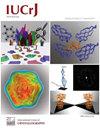利用扩展范围高能量分辨率荧光检测和主成分分析的先进结构见解,在金属锰的Kβ光谱中发现能量依赖的多体过程。
IF 3.6
2区 材料科学
Q2 CHEMISTRY, MULTIDISCIPLINARY
引用次数: 0
摘要
本文介绍了锰的Kβ发射光谱中n = 2卫星跃迁的新发现及其随入射光子能量的演化。利用XR-HERFD(扩展范围高能分辨率荧光检测)技术,我们最终证明了这一现象的存在,在整个测量光谱中对应的统计显著性为652 σse,远高于3-6 σse的发现阈值。我们将主成分分析(PCA)应用于XR-HERFD数据,以提取先进的结构见解。这种新的光谱特征和物理过程的演变通过结合回归来量化,揭示了在大范围内入射光子能量的强度增加。我们通过独立的测试数据验证了这些发现。这些结果直接挑战了在标准XAFS (x射线吸收精细结构)方程中,将多体还原因子S02作为独立于入射光子能量的常数的传统处理方法。因此,这些结果提供了令人信服的证据,表明S02应该被建模为入射光子能量的变化函数,这标志着在Kβ光谱中首次观察到这种行为。这有助于对HERFD光谱的更大定量理解和凝聚态系统中多体效应的全面表示。本文章由计算机程序翻译,如有差异,请以英文原文为准。
Discovery of an energy-dependent many-body process in the Kβ spectrum of manganese metal using extended-range high-energy-resolution fluorescence detection with advanced structural insights from principal component analysis
A new satellite is discovered in the manganese Kβ spectrum using extended-range high-energy-resolution fluorescence detection. Advanced insights on its structure and evolution are extracted with principal component analysis.
The discovery of the novel n = 2 satellite transition in the Kβ emission spectrum of manganese and its evolution with incident photon energy are presented. Using the XR-HERFD (extended-range high-energy-resolution fluorescence detection) technique, we conclusively demonstrate the existence of this phenomenon with a statistical significance corresponding to 652 σse across the measured spectrum, far above the discovery threshold of 3–6 σse. We apply principal component analysis (PCA) to the XR-HERFD data to extract advanced structural insights. The evolution of this novel spectral feature and physical process are quantified by incorporating regression, revealing the increase in intensity over a wide range of incident photon energies. We validate these findings through independent test data. These results directly challenge the conventional treatment of the many-body reduction factor S02 as a constant independent of incident photon energy in the standard XAFS (X-ray absorption fine structure) equation. Thereby, these results present compelling evidence that S02 should be modelled as a varying function of incident photon energy, marking the first observation of this behaviour in Kβ spectra. This facilitates a greater quantitative understanding of HERFD spectra and a comprehensive representation of many-body effects in condensed matter systems.
求助全文
通过发布文献求助,成功后即可免费获取论文全文。
去求助
来源期刊

IUCrJ
CHEMISTRY, MULTIDISCIPLINARYCRYSTALLOGRAPH-CRYSTALLOGRAPHY
CiteScore
7.50
自引率
5.10%
发文量
95
审稿时长
10 weeks
期刊介绍:
IUCrJ is a new fully open-access peer-reviewed journal from the International Union of Crystallography (IUCr).
The journal will publish high-profile articles on all aspects of the sciences and technologies supported by the IUCr via its commissions, including emerging fields where structural results underpin the science reported in the article. Our aim is to make IUCrJ the natural home for high-quality structural science results. Chemists, biologists, physicists and material scientists will be actively encouraged to report their structural studies in IUCrJ.
 求助内容:
求助内容: 应助结果提醒方式:
应助结果提醒方式:


